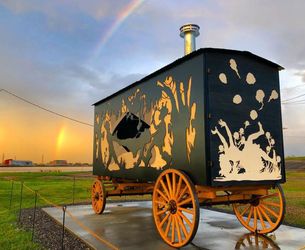Last week, I talked about the similarities between what happened in New Orleans ten years ago, and what happened in the month gone by in Kerala. This is what Hurricane Katrina did to New Orleans: nearly 2,000 deaths, more than $100 billion in damage, flooding in 80 per cent of the city, and the displacement of 400,000 residents. The impact of the floods in Kerala is yet to be completely assessed, though the government estimates that rebuilding would require about Rs 30,000 crore.
The case of New Orleans is worth going back to for more reasons than one. In the Kerala government’s decision to cancel all cultural festivals for one year, including the International Film Festival, makes it all the more relevant. Despite state apathy, New Orleans recovered fast. Much of its convalescence was catalysed by a vibrant art community, which not only restored the fabric of the city of music, Mardi Gras and memories but also recast its future.
It began with Prospect 1, an art biennale that was instituted and hosted by New Orleans within a month after the tragedy and went on for four months. It was the idea of international art curator of Dan Cameron, who had first-hand experience of witnessing host cities reaping huge rewards, both social and financial, from biennale exhibitions. Prospect 4, which ended in February this year, is now a major platform for artists from the Global South. Not only did it make a tremendous impact on cultural tourism but it also inspired artists embrace the social mission of the biennale, and created projects that resonate deeply with the city’s unique history, culture, people, and institutions.
Prospect was not the only thing that Katrina triggered culturally. There was a multi-media dance festival called Katrina Katrina: Love Letters to New Orleans; since then D.C. Blues Society has been dedicating its 18th annual festival to the music of New Orleans; that year the PEN/Faulkner opened its season with a New Orleans Night, with renowned authors reading New Orleans stories. But the hallmark of the post-Katrina year was a stupendous show titled Seeing Is Believing, Seeing Is Healing.
No one doubts the noble intention behind diverting finances set aside for cultural festivities to the disaster relief fund. But I cannot fathom the fact that it stems from the belief that art and culture is a luxury. I feel art has a crucial role to play in the reconstruction of Kerala.
When Hurricane Sandy hit the New York City, the US Department of Arts and Culture (USDAC) published a report titled Art Became the Oxygen: An Artistic Response Guide, in which it argued that “crises need creativity”. Art has always been not only about visual or aesthetic pleasure, which is important, but also about creative responses to emergent situations. Nature has bestowed us abundant splendour, but our modern practices of architecture and urbanisation have worked against both the benefactor and those who benefitted. When we rebuild Kerala, it should be done with a complete understanding of our inheritance. Our standardised, context-free building and zoning practices that respond only to expediencies of economics will not do anymore. Art that is aware and sensitive of its materials and its context, and thinks beyond any immediacy can contribute greatly. Instead of turning its back to art activities in the name of austerity, Kerala should adopt curated/edited “emergency arts”, the coming together of artistic practice, emergency management, and community development.
editor@theweek.in


